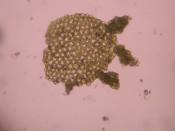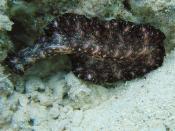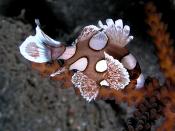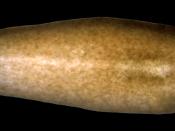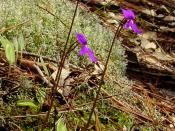The ability to replace an injured portion of an organism's body is known as regeneration. Regeneration of free living flatworms is most common pronounce among "more basal taxa (Aceola, Catenulida, and Macrostomorpha) as well as in more derived taxa (Tricladida and Neodermata)" (Egger et al., 2007). The major free living flatworm taxa, with the exception of Nermodermatida, show some capacity to self regeneration damaged or missing tissues. The term planarian is used to designate a specific group of free living flatworms know as triclads. The triclads have been the focus of the majority of regenerative studies conducted on free living flatworms. The planarians are an ideal organism to study regarding regeneration because "they are one of the simplest bilaterians known to display robust regenerative capacities" (Alvarado, 2006). The planarians are mainly recognized "for their capacity to regenerate complete individuals from miniscule body parts" (Alvarado, 2006). Scientists have been particularly interested in flatworm regeneration recently because of its close relation to stem cells and embryogenesis.
The mitotically active neoblast cells of the free living flatworms are currently being investigated in order to better understand the regeneration process. Somatic cells called neoblasts are found in the regeneration blastema of the flatworms. Neoblasts function by replaceing cells lost due to normal physiological turnover as well as replacing lost tissues due to amputation. The capability to regenerate is a trait that is expressed in very few of the animals in higher taxa than the free living flatworms. With such useful applications, researchers are looking into the reasons why this trait was not passed on to the higher animals. One of the main reasons proposed by researchers is that "other than as a side effect of asexual reproduction, the ability to regenerate is seemingly not useful enough to outweigh the inherent dangers" (Egger et al., 2007). A better understanding of the regeneration process in free living flatworms will provide for future advancements in regenerative medicine. This review aims to explain the factors that control and effect free living flatworm regeneration, and the practical applications of studying the regenerative capabilities of free living flatworms.
In order to best understand the processes of free living flatworm regeneration researchers are focusing on the factors that inhibit or incapacitate the regenerative capability of the flatworms. One of the earliest and most notable factors that is thought to have some effect on regenerative capability, is the ability of the organism to reproduce asexually. Egger notes that "in taxa lacking asexual reproduction, the regeneration capacity is generally less pronounced than in taxa with asexual reproduction" (Egger et al., 2007). There are two different forms of asexual reproduction that are exhibited in the free living flatworms. The first type of asexual reproduction, architomy, is where the "regeneration event follow fission" of the reproducing flatworm (Eggers et al., 2007). The second type of asexual reproduction in free living flatworms is called paritomy. Paritomy is where the organs are produced in the flatworm before fission. Paritomy is more accurately referred to as pregeneration due to the nature of the process. When fission during paritomy is artificially induced the daughter organism often fails to produce a head. The difference between architomy and paritomy could explain much of the difference between regenerative capabilities in flatworms that exhibit asexual reproduction. The main difference between regeneration and pregeneration is the presence of the head ganglion, "which is regarded as a decisive organ for regeneration in many species" of free living flatworms (Egger et al., 2007).
Based on several different experiments which dealt with Paramecynostomum diversicolor and Polychoerus caudatus, researchers have determined that members of Aceola are "not able to regenerate ganglia (brain) or statocyst" during regeneration (Egger et al., 2007). In other experiments conducted on different taxa of free living flatworms, many species were incapable of reproducing a head region from a posterior portion of the organism. Eggers suggests that "serotonin and possible other substances related to the brain or nervous system might be key factors deciding on the regeneration capacity of flatworms" (Eggers et al., 2007).
Another possible factor that might be responsible for the inhibition of regeneration in free living flatworms is the presence of ovaries. Some of the free living flatworms such as Stenostomum alternate "seasonally between sexual and asexual reproduction", a trait know as protandic hermaphroditism (Egger et al., 2007). In experimentation by van Cleave in 1929; "asexual and male specimens of Stenostomum grande can regenerate all organs, but lose their ability to regenerate a head after the appearance of ovaries" (Egger et al., 2007). This observation hints that there might be some sort of regulatory substance that is produced by the ovaries to reduce the regenerative potential of the organism. However, at this current point in time "the molecular nature of such an inhibitory substance remains unclear" (Egger et al., 2007). Also, there have been other studies on S. mediterranea that suggest gonads are not inhibitory in all species of flatworms and that the case with S. grande may just be an isolated incident. The idea that individual species could regenerate before reproductive structures were formed then raised questions about the capabilities of juveniles to reproduce.
If the gonads, or more specifically ovaries, were causing interference in the regeneration process then it would be logical to assume that juveniles who do not yet contain mature gonads would still have excellent regenerating capabilities. In the taxa Mesostoma "young animals (the author does not specify their age) are reported to regenerate better than adults" (Egger et al., 2007). In other species such as H. giselae "no regeneration even of large juvenile (2.5 mm long) takes place" (Egger et al., 2007). In triclad studies the juveniles were able to regenerate at the same rate as adults. Another study done on M. lignano shows "that even young animals (1 Day after hatching) are capable of regeneration, indicating that the neoblast stem cell system is already present and functional as found in adults" (Egger et al., 2007). Therefore, adults and juveniles should for the most part experience the same regenerative capabilities. This difference in results could point to a substance which is regulatory in some species and not in others; therefore, accounting for the dramatic span of regenerative capabilities in juvenile free living flatworms.
One of the more recent studies and possibly the most profound shows there is a definite relation between beta catenin and planarian regeneration and homeostasis. Beta catenin is a protein that is found both in vertebrates and invertebrates. It has previously been known to control "transcription output as well as cell adhesion" (Gurley et al., 2008). Beta catenin controls a wide range of cellular processes and is a very important protein in embryonic development. During regeneration, a planarian is able to differentiate between its anterior and posterior; this concept is called anteroposterior (A/P) identity. When the organism is treated with RNAi to silence the genes controlled by beta catenin "striking alterations in the anteroposterior" identity of the organism occurred (Gurley et al., 2008). The RNAi that silences the gene for beta catenin is most commonly known as Dishevelled, which consists of Smed-bcatenin-1 and Smed-APC-1. When a planarian was introduced to Dishevelled it was no longer able to discern between anterior and posterior portions during regeneration. When severed, the posterior portion of the planarian would regenerate another posterior portion. This mutation effectively created a planarian with two tails facing each other. The anterior severed portion would also regenerate another head, which was arranged in the same fashion as the two tail portions. In order to insure that these changes where not merely superficial, "anatomical and molecular markers of A/P identity" where used on the test organisms (Gurley et al., 2007). Also, the two asymmetrical organ systems of the planarian were also closely monitored. The two organ systems that were monitored were the central nervous system and the digestive system. The makers clearly showed that the portion that was severed was only capable of producing organs from that segment. The posterior tail was not able to produce any discernable brain tissues. Researchers also noted that the "mis-specified heads and tails in RNAi treated worms moved independently from the rest of the animal; hence this tissue was functioning autonomously" (Gurley et al., 2008). This is sufficient result to show that the silencing of Smed-bcatenin-1 and Smed-APC-1 "is sufficient to mis-specify blastema identity" (Gurley et al., 2008). Researchers then conducted studies to determine at what point in time the regulators of beta catenin and APC were involved in regeneration. The results indicated that the activity of the proteins "act very early to determine blastema identity" (Gurley et al., 2008). This data shows that beta catenin could play a very important role in the promotion of regeneration in planarians. Not only then would beta catenin control regeneration in planarians, but this could also link beta catenin to promotion of regeneration in metazoan embryogenesis.
Studying regeneration in planarians can provide many practical uses regarding regeneration in higher metazoans. Regeneration studies could also provide valuable insight and understanding of biological functions. When studying the genes of many free living flatworms researcher saw "a group that is conserved between planarians and mammals" (Newmark, 2005). These groups of genes are thought to be involved with regeneration maintenance in tissues and cell replacement. Closing the gap between planarian regenerative capabilities and human daily regeneration could provide life saving solutions for people suffering from nerve tissue damage, cancer and a variety of other horrible diseases that plague the human race. Also simply studying the mechanisms of regeneration in lower animals can give researchers insight into the workings of human regenerative capabilities and how to manipulate them. Reddien states that the "Planarians have solved exactly what people want to accomplish with regenerative medicine" (Reddien, 2005). Studies of planarians and flatworms are constantly turning up new proteins such as smedwi-2 that are shared by both humans and planarians. These types of discoveries could lead to saving millions of lives, making planarian studies much more important.
The fact that lower animals can regenerate yet higher animals cannot begs the question: why would such a useful skill get lost throughout natural selection? The problem is that there are a lot of side effects that go along with the regenerative capability. The chances that only part of an organism will be affected by a disease or some sort of injury do not outweigh the possible dangers of a "totipotent stem cell out of control" (Egger et al., 2007). Regeneration takes time; the chances of an organism getting injured and surviving, or having the necessary time after an injury are much less likely than the risk of regeneration warrants.
�
Literature Cited
Alvarado. 2006. Planarian Regeneration: Its End Is Its Beginning. Cell 124: 241-45.
Cameron. 2005. November. Flatworms yield insights into the mystery of regeneration Retrieved 16 October 2008 from Whitehead Institute for Biomedical Research http://www.wi.mit.edu/news/archives/2005/pr_1122.html
Egger, Gschwenter, and Rieger. 2007. Free-living flatworms under the knife: past and present. Development Genes and Evolution 217: 89-104.
Gurley, Rink , and Alvarado. 2008 b-Catenin Defines Head Versus Tail Identity During Planarian Regeneration and Homeostasis. Science Express 319 5861: 232-27.
Newmark. 2005. December. Human Diseases, Researchers Say. Retrieved 16 October 2008 from Science Daily <http://www.sciencedaily.com/releases/2005/12/051213174134.htm>
